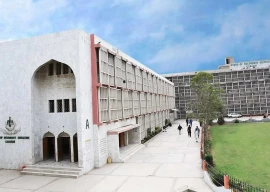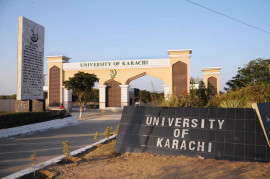
As far as road traffic injuries are concerned, Jalaluddin Qureshi has had more than his share. He has a left arm with limited movement to remind him each day.
Qureshi’s first road traffic accident took place about a decade ago when he hit a rickshaw on his way home from work. The impact caused a fracture in his left arm but he managed to return to work a week later.
His second encounter, about five years back, was more severe. On his motorcycle from Korangi to the Karachi Press Club at around 11 pm, Qureshi says he was hit by a moving object — he has no recollection of what hit him. “I am told that I arrived at the press club on my motorcycle with a head wound and both wrists fractured.” It took him almost two months to recover.
Qureshi’s injury is one of over 30,000 recorded every year in the city, according to the RTI Research and Prevention Centre at the Jinnah Postgraduate Medical Centre (JPMC). In fact, an astounding 25 to 50 per cent of deaths are “most likely” caused by road traffic injuries (RTI) in the country. In a stark contrast, police records say an average of just 700 RTIs take place every year.
The RTI centre at JPMC has been officially operational and collecting data since 2007. This study consolidates and analyses data from the emergency wards of five major hospitals in the city — Civil Hospital, Karachi, JPMC, Abbasi Shaheed Hospital, Liaquat National Hospital and Aga Khan University Hospital (AKUH).
Digging deeper into the data, RTI centre’s programme manager Syed Ameer Hussain said motorcyclists are most prone to injuries — over 60 per cent of the incidents. “When speaking of fatalities, more than 40 per cent are pedestrians,” he said. According to a World Health Organisation (WHO) study conducted in 2009, 45,000 deaths were recorded every year in Pakistan from RTIs with about 70 per cent of the victims aged between 15 and 45 years. Eighty per cent of those killed were men.
“A concerted effort needs to be made to make roads safer for pedestrians. Our government’s focus has been on making roads better for cars and its drivers but all these open roads and signal-free corridors do make cars speed more,” says the WHO Collaborating Centre on Emergency Medicine and Trauma director, Dr Junaid Razzak.
Criticising the design of many pedestrian bridges built without proper planning, he urges drivers to “slow down”.
Mauripur dangerous
The centre declares Mauripur the “most dangerous road” in the city with pedestrian accidents per kilometre recorded at 63.5. Since January 2008, 120 people have died and 1,500 have been injured on the road that leads to the city’s beach. Second to Mauripur is Korangi with an accident rate of 42 pedestrians per kilometre.
September was the deadliest month with the highest number of accidents last year, totalling 2,982.
Drunk driving
The official percentage for accidents caused by drunk drivers is zero. But private hospitals do not conduct tests to check alcohol levels. “In Pakistan, we do not even recognise this as a problem. Patients admitted to emergencies are not tested because it isn’t mandatory by law and since they are paying out of their own pocket, they immediately question why a particular test was done and can refuse to pay for it,” Razzak explains. Perhaps a pilot study is what is desperately required, he suggests.
Programme manager Hussain agrees, “There should be a mandate to test for alcohol levels. Prevention is better than spending a great deal of money on injuries later. Most crucially, it should be mandated for commercial drivers and those operating heavy good vehicles (HGV).”
Forty per cent of RTI fatalities are caused by HGV drivers.
Hussain says ambulance services are also using this data to position their vehicles near dangerous spots.
Police records in 2010
Road traffic injuries: 1,099
Road traffic fatalities: 491
RTI Centre for Research and Prevention Centre
Road traffic injuries: 30,340
Road traffic fatalities: 1,227
Published in The Express Tribune, March 12th, 2011.

















COMMENTS
Comments are moderated and generally will be posted if they are on-topic and not abusive.
For more information, please see our Comments FAQ